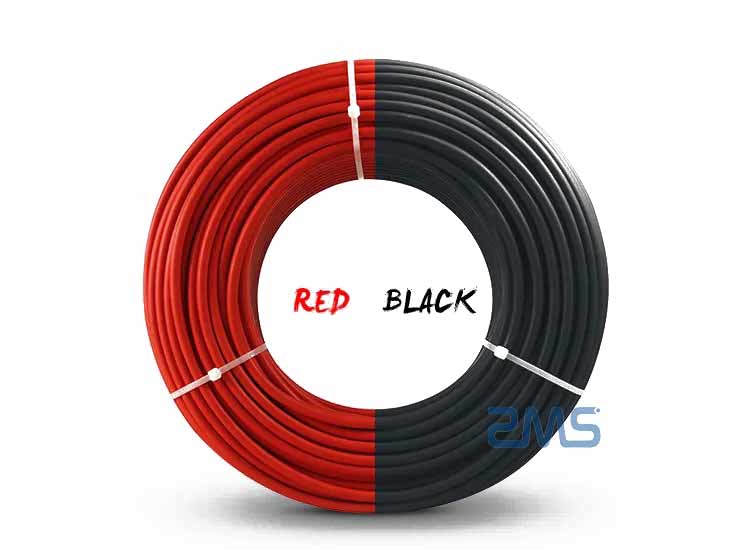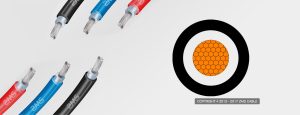

Fotovoltaik kabel dirijor materialı ümumiyyətlə mis dirijor və ya konservləşdirilmiş mis dirijordur.
Effektiv və sərfəli fotovoltaik elektrik stansiyalarının tikintisi bütün günəş kabeli istehsalçılarının ən vacib məqsədi və əsas səriştəsini təmsil edir..
Mənfəətlilik təkcə günəş modullarının özlərinin səmərəliliyindən və ya yüksək performansından asılı deyil, həm də səthdə olan bir sıra komponentlərdə modullarla birbaşa əlaqəli görünmür.
Misal üçün, Bir PV zavodu düzgün kabellərdən istifadə edə bilmirsə, Bütün sistemin ömrü təsir edəcəkdir.
Belə ki, Bir pv kabeli nədir?
PV kabel, qiymətləndirilən bir elektron şüa çarpaz bir link kabelidir 120 °C. Bu reytinqə uyğundur 18 davamlı bir temperaturda xidmət illəri 90 °C. Və temperatur aşağı olduqda daha uzun davam edir 90 °C.


The Günəş kabellərinin xüsusiyyətləri xüsusi kabel izolyasiya və örtük materialı ilə müəyyən edilir, çarpaz əlaqəli pe adlanır. Kabel materialının molekulyar quruluşunu dəyişdirmək və beləliklə fərdi xüsusiyyətlərini təmin etmək üçün bir şüalanma qaz pedalı ilə şüalanmışdır. Quraşdırma və texniki xidmət zamanı, Kabel dam quruluşunun kəskin kənarlarında yönləndirilə bilər. Kabel təzyiqə məruz qalır, əyilmə, gərginlik, Çarpaz gərginliklər, və güclü təsirlər.
Kabel qabığı kifayət qədər güclü deyilsə, Kabel izolyasiyası ciddi şəkildə zədələnəcəkdir. Beləliklə, bütün kabelin həyatına təsir göstərir, və ya qısa sxemlərə aparan, Yanğınlar və xəsarətlər, və digər təhlükəli problemlər.
Günəş fotooltaik elektrik stansiyalarının inşaat prosesindəki əsas avadanlıqlara əlavə olaraq. Kimi fotovoltaik modullar, inverters, və pilləkən transformatorları. Əlaqəni dəstəkləməkdən əlavə günəş kabeli Fotovoltaik elektrik stansiyalarının ümumi gəlirliliyinə materiallar. Əməliyyatın təhlükəsizliyi, İstərdən səmərəlidir, Ayrıca həyati bir rol oynayır.
Aşağıdakılar, fotovoltaik elektrik stansiyalarında istifadə olunan ümumi kabellərə və materiallara və onların ətraf mühitin istifadəsinə dair ətraflı bir girişdir.
Fotovoltaik elektrik stansiyası sisteminə görə kabellər DC kabellərinə və AC kabellərinə bölünə bilər, Fərqli mühitlərin istifadəsinə və istifadəsinə görə aşağıdakı kimi təsnif edilir:
1 Komponentlər və modullar arasındakı seriya kabelləri.
2 Strings və strings və DC arasındakı paralel kabellər Paylama qutusu.
3 DC Distribution Box və İnverter arasında kabel.
Yuxarıdakı kabellər DC kabelləridir, daha tez-tez açıq havada qoyulmuş və nəmli olmalı olanlar, günəşdən keçirməyən, soyuqqanlı, istilikverici, və uv-sübut. Və bəzi xüsusi mühitlərdə, Alar və qələvilər kimi kimyəvi maddələrdən də qorunmaq lazımdır.
1 İnverter transformator bağlantısı kabelinə qədər inverter.
2 Paylaşım vahidinə addım-up transformatorundan əlaqə kabeli.
3 Paylama bölməsindən şəbəkə və ya müştəriyə bağlantı kabeli.
Kabelin bu hissəsi AC yükləmə kabelidir, qapalı mühit daha çox yatır, ümumi güc kabel seçimi tələblərindən sonra seçilə bilər.
Günəş enerjisi photovoltaik elektrik stansiyaları çox sayda DC kabellərində açıq havada qoyulacaq, Sərt ekoloji şəraitdə. Kabel materialı ultrabənövşəyi işığa qarşı müqavimətə əsaslanmalıdır, ozon, Şiddətli temperatur dəyişiklikləri, və kimyəvi eroziya.
Bu mühitdə ümumi maddi kabel uzun müddətdir kobudluğun kövrək olmasına səbəb olacaqdır, və hətta parçalanma Kabel izolyasiya təbəqəsi.
Bu şərtlər kabel sisteminə birbaşa zərər verə bilər və həmçinin kabelin qısa dəyirmanı riskini artıra bilər.
Orta səviyyədə uzunmüddətli, Kadrlar üçün yanğın və ya yaralanma ehtimalı da daha yüksəkdir, sistemin xidmət həyatına çox təsir edir. Buna görə də, PV elektrik stansiyalarında pv-spesifik kabellər və komponentlərdən istifadə etmək vacibdir.
PV-spesifik kabellər və komponentlər yalnız havaya davamlıdır, UV, və ozon hücumu, lakin daha çox temperatur dəyişikliyinə tab gətirə bilər.
İstifadə olunan kabellər Aşağı gərginlikli DC ötürülməsi Günəş PV güc sisteminin bir hissəsi fərqli komponentlərin bağlanması üçün fərqli tələblərə malikdir. Çünki istifadə ətraf mühit və texniki tələblər.
Hesab ediləcək ümumi amillər kabel izolyasiya performansıdır, İstilik və alov müqaviməti, yaşlanma performansı, və tel diametrli xüsusiyyətlər.
Xüsusi tələblər aşağıdakı kimidir:
Ümumiyyətlə, birbaşa qoşulmaq üçün modul qovşaq qutusuna qoşulmuş bağlantı kabelindən istifadə edin, Uzunluğu xüsusi bir uzantı kabelindən istifadə etmək üçün kifayət deyil.
Komponent gücünün ölçüsündən asılı olaraq, Bu tip bağlantı kabelində çarpaz bir bölgəyə malikdir 2.5 m㎡, 4.0 m㎡, 6.0 m㎡, və digər üç spesifikasiyalar.
Bu tip bağlantı kabeli izolyasiya qabığının ikiqat qatından istifadə edir. Ultrabənövşəyi işığa üstün müqavimət göstərən, su, ozon, turşu, və duz eroziyası, Üstün hava qabiliyyəti, və taxma müqaviməti.
UL-sınaqdan hazırlanmış çoxlu bir çevik kabeldən istifadə etmək və mümkün qədər yaxınlaşmaq tələb olunur.
Qısa və qalın kabelləri seçmək sistemin itirilməsini azalda bilər, səmərəliliyi yaxşılaşdırmaq və etibarlılığı artırmaq.
UL-sınanmış çox qapalı istifadə etmək də tələb olunur çevik kabel, və kəsişmə sahəsi serialın maksimum çıxış cərəyanına əsaslanır.
Hər hissənin DC kabel kəsişmə sahəsi aşağıdakı prinsiplərə görə müəyyən edilir:
Günəş modulları və komponentlər arasında əlaqə kabeli üçün, Batareya və batareya arasındakı əlaqə kabeli. Və AC yükü üçün əlaqə kabeli, Kabel cari reytinqi ümumiyyətlə seçilir 1.25 hər kabeldə maksimum davamlı əməliyyat cərəyanı.
Günəş hüceyrə serialları və seriallar arasındakı əlaqə kabelləri, Batareya bankları və inverterlər arasındakı əlaqə kabelləri. Ümumiyyətlə, Seçilmiş kabeldən qiymətləndirilən cərəyan 1.5 hər kabeldə maksimum davamlı əməliyyat cərəyanı.
Yuxarıda göstərilənlər günəş kabellərinə ümumi bir girişdir, Kabellər üçün alış-veriş edərkən bəzi mülahizələr kimi. ZMS kabel istehsalçısı var vəd edir günəş kabelibeynəlxalq standartlara əsasən istehsal olunur, həm də müxtəlif komponentlər və tam xidmətlər. Günəş kabellərinin alınması ilə bağlı hər hansı bir sualınız varsa, Xahiş edirəm bizə müraciət etməkdən çekinmeyin. Və sizə kömək etmək üçün peşəkar bir kabel satış nümayəndəsi olacaq.
İnsanlar mineral izolyasiya edilmiş kabel termini eşitdikdə, many immediately think of harsh environments like…
Telekommunikasiya şəbəkələri və enerji ötürücü sistemləri sürətlə böyüyür, the demand for reliable and cost-effective…
Güclü neft və qaz layihələrində, Sənaye kabelləri yalnız aksesuar deyil—they are the "nervous…
Elektrik bağlantıları dünyasında, kabel qapaqları—Kabel qulaqları və ya kabel terminalları kimi də tanınır—var…
Elektrik mühəndisliyi layihəsi üçün düzgün rezin kabel seçərkən, it is critical to…
Əziz tərəfdaşlar və müştərilər: 29 yanvar, 2025 Çin Aysal Yeni ilidir – Spring…